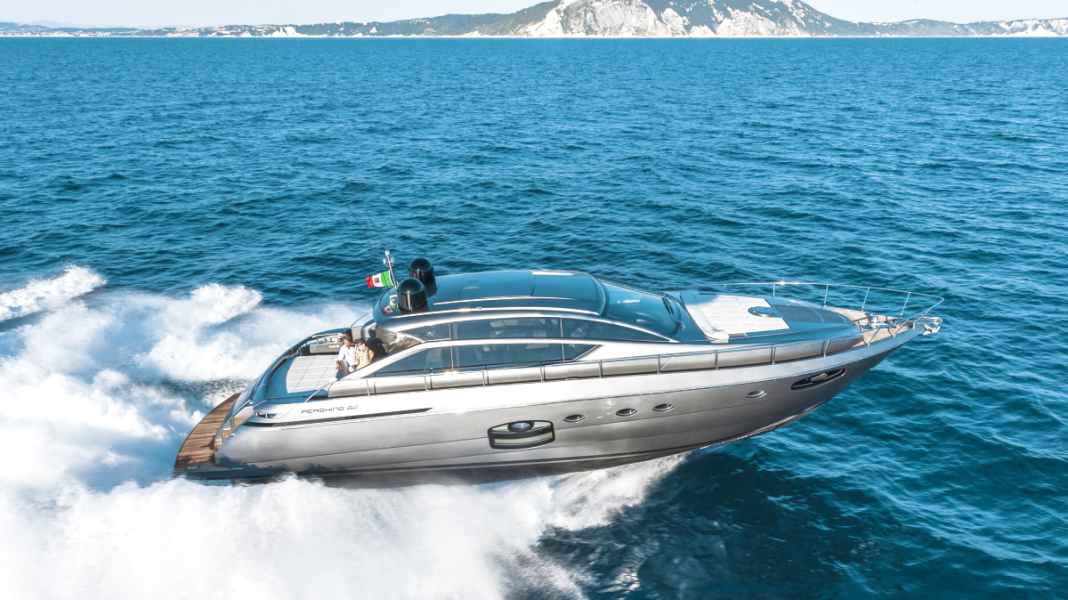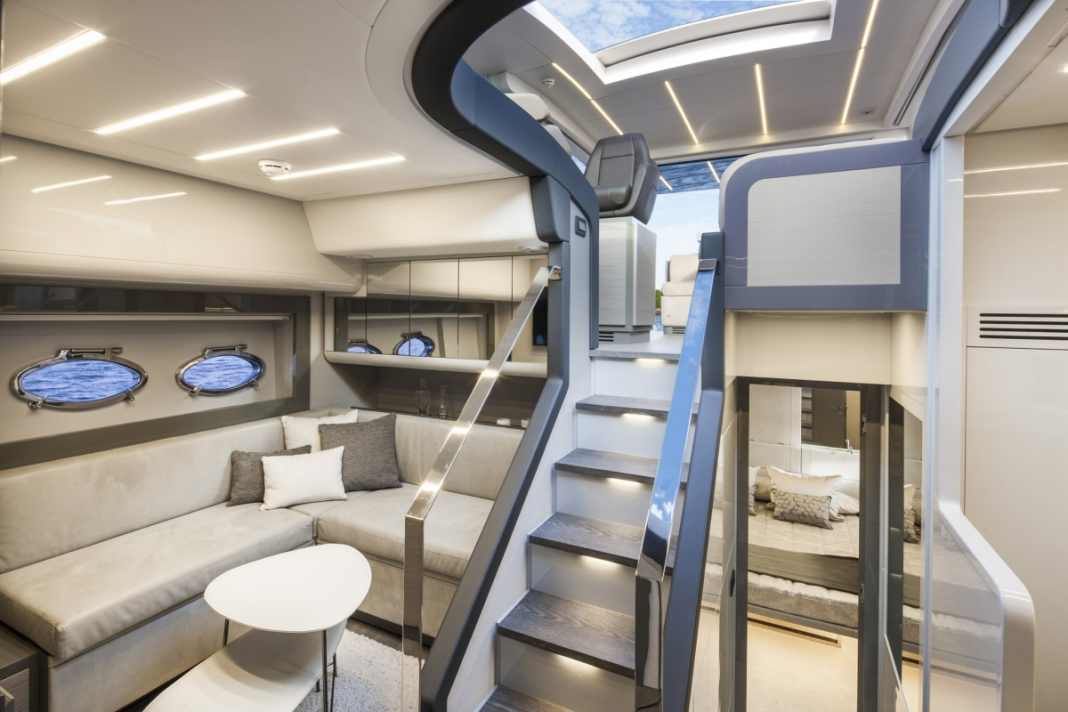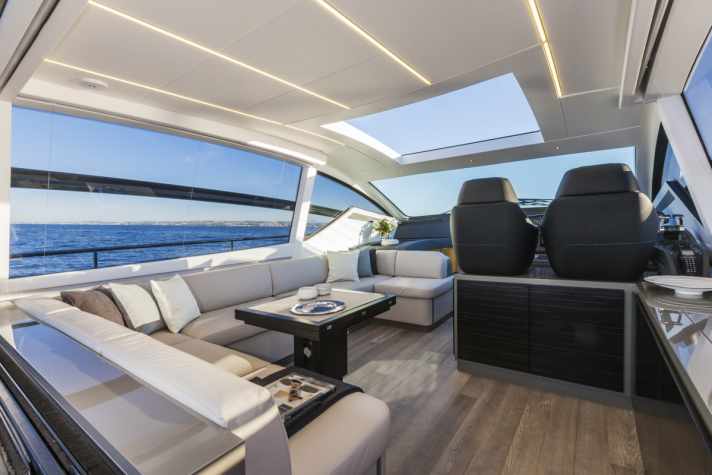Pershing 62 - The Pershing 62 flies by like a bullet

What leaves the halls here is unquestionably one of the finest and fastest floating products: Pershing is the noble forge in the Italian Ferretti Group. The workmanship of the boat leaves nothing to be desired, Pershing produces at the highest level using the best materials. Customers can choose from a range of colours and materials and combine them to suit their preferences.
As far as the test boat is concerned, everything fits together harmoniously. If there were grab handles in the saloon and cockpit, none of which are visible because they detract from the owner's appearance, you could say: perfect. This also applies to the handrails along the outside of the side windows, where they functionally complement the design.
A Pershing is driven by surface drives from Arneson, where powerful engines do their work in front; in the test boat, two V-ten-cylinder engines from MTU with 1523 hp each fulfil the demands placed on them. And counter-rotating propellers with a diameter of almost one metre and a pitch that theoretically propels the boat 1.42 m at one revolution convert speed into thrust. The latter is powerful, which is why it is better to use trolling mode in the harbour, which reduces the speed at the gearbox output and thus allows both propellers to turn more slowly. We measure a speed of 3 knots in this mode, without it the speed is 8 knots at the same engine speed. Counter-rotating drives stand for manoeuvrable behaviour at slow speeds. One shift lever forwards, the other backwards, and one turning circle measures the length of the boat. If both gear levers are set to "ahead" when the rudder is fully turned, the boat is two and a half metres long.






It starts with the drives "at the bottom", which are then slowly trimmed up as the speed increases. In the process, the Pershing increasingly gains momentum while the engine computers monitor the torque, injection quantities and engine speeds. When the revs reach the 2000 rpm mark, the second set of turbochargers switches on, which then really "fire up" and allow the 62 to storm ahead up to top speed. The foresight is maintained when starting off; in unfavourable cases, the foredeck and horizon form a line if the drives are operated manually instead of using the automatic trim. The automatic system operates both trim tabs and drives and works perfectly.
When the Pershing 62 is planing, the speed is not just a result of putting both throttles on the table. The speed only becomes apparent when the drives are trimmed up and the proverbial Rustertail (cock's tail) rises behind the boat. If you do everything right, you can accelerate up to 47 knots while the engines rev up to the permitted limit of 2450 rpm. Don't forget that you are moving around 35 tonnes over the water! In terms of range, this means that at slow speed you can theoretically travel just under 700 nm, at fast and economical cruising speed (39 kn) one tank of fuel is enough for around 228 nm, and at full throttle it is 7 nm less until the reserve is reached. This means that the Pershing 62 does not fulfil our minimum range requirement of at least 270 nm plus reserve. Effective sound insulation ensures that the sound pressure in the closed saloon remains below a pleasant 78 dB/A. If you like it louder, go into the cockpit.
The manoeuvres performed at full throttle give no cause for criticism. The Pershing 62 performs manoeuvres with unerring confidence. However, as long as the sunroof remains closed, you are flying blind when cornering on the port side. And over starboard you have to duck a little to have a good view. On the other hand, the view aft always remains unclouded. On the test day, the Mediterranean Sea off La Spezia was "calm", which is why we cannot comment on the rough water qualities of the 62, which is certified for the high seas.
A hatch in the cockpit floor leads down into the fully accessible engine compartment, where everything is neatly installed. Except for the outside, both engines are easily accessible. Fuel pre-filters are fitted with water alarm sensors that inform the skipper at the helm. The batteries are switched via relays. A fire extinguishing system should prevent the worst in an emergency - the shipyard has dispensed with a manual bilge pump.
Our test boat is equipped with three cabins plus one for the crew. Each has its own bathroom, with the one on the starboard side also being reserved for day guests. The owner stays in a suite under the saloon floor. It goes without saying that there is no lack of comfort. The well-equipped galley in the test boat is located in the living area and separated by a door. The sliding door and window that separate the saloon from the cockpit can be lowered. If the sunroof is then opened wide, the Pershing becomes an open-air boat. Sun-seekers can use the sun loungers aft and on the foredeck. A tender is hidden in the garage between the engine compartment and the stern sunbed, which can easily be lowered into the water thanks to the lowerable bathing platform. Pershing equips the 62 ready to go, but still leaves room for customisation thanks to the list of accessories. The fact that the 62 does not have a rubbing strake worthy of its name is down to the designer.

Conclusion:
The Pershing 62 is characterised by the finest handling characteristics and agile reactions that can be "addictive", on which the control stand and joysticks for power trim, steering and trim tabs evoke "the play instinct for driving fun". If you have any concerns about the correct trim, tick "automatic trim" on the accessories list. It operates both the trim tabs and the drives and works perfectly. Because of such pleasures, the owner naturally likes to steer the Pershing 62 himself. Thanks to the technology, you get the impression that you are "only" moving a larger sports boat - but below deck, the little one becomes a really big one with the highest feel-good factor.
Data sheet: Pershing 62
Shipyard: Ferretti S.p.A.
Type designation: Pershing 62
CE category: A - High seas
Material of hull and deck: Plastic
Length: 18,94 m
Width: 4,80 m
Displacement: 33,40 t
Price: 2.820.300,00 €

